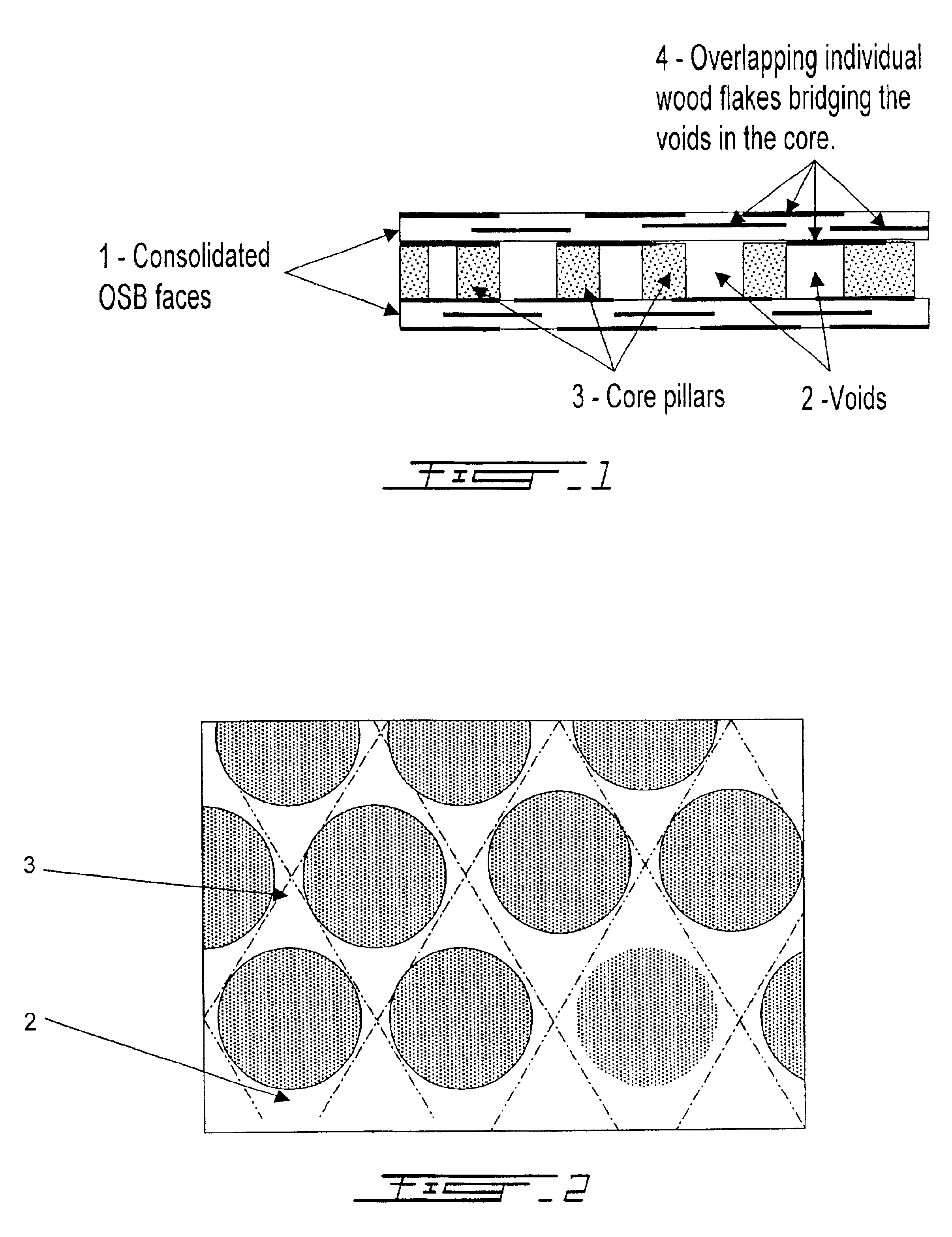Composite board with OSB faces
a composite board and face technology, applied in the field of oriented strand board (osb) technology, can solve the problems of void space adding weight, requiring more than one step in the manufacturing process of such a board, and consuming wood, and achieve the effect of reducing the weight of the panel and ensuring the strength of the cor
- Summary
- Abstract
- Description
- Claims
- Application Information
AI Technical Summary
Benefits of technology
Problems solved by technology
Method used
Image
Examples
example 1
describes 4 separate board preparations, 2 of them using 100% MOW material as a core the other 2 use 100% PPS material (see Table 1). Thirty-seven percent (37%) water solution of phenol-formaldehyde resin was sprayed on both sides of the core to add about 3% dry weight of the resin. The core samples (perforated mats with resin) were placed between two layers of face wafers that were blended with about 2.5% dry PF resin and pressed in a 20″×20″ laboratory press. The face wafers that were used were aspen hardwood face wafers, which were obtained as a “grab” sample from the standard OSB production line. The conditions of pressing in the laboratory press were as follows: 200 seconds under 12 Mpa pressure and 215° C. temperature. The results are summarized in Table 1.
TABLE 1Make-up and Properties of Composite PanelsSampleControlMOW-1MOW-2PPS-1PPS-2 CoreWoodFiberFiberFiberFiberflakesmatmatmatmatFace amount425 g425 g500 g425 g500 g(each side)Thickness0.4200.4120.4190.4500.413Density4229.13...
example 2
A continuous non-perforated fiber mat was made from recycled primary papermaking sludge (PPS) uniformly impregnated with PF resin solution to the levels of 3% and 5% dry resin by weight. The mats were dried without inducing resin polymerization. The core samples were placed between two layers of face wafers that were blended with 2.4% dry PF resin and pressed in a 20″×20″ laboratory press. The same materials and conditions as in the first example were used.
The obtained properties are summarized in Table 2, demonstrating that the complete replacement of wood wafers by a recycled primary papermaking sludge that contained a small percentage of PF resin gives a panel with nearly normal strength and density, with a 30% reduction in wood consumption.
TABLE 2Make-up and Properties of Composite PanelsSampleControlPPS-3PPS-4 CoreWood flakesFiber matFiber mat% PF resin in the core2.435Face amount (each side)425 g498 g519 gThickness0.4200.4200.418Density423737Internal Bond604139MOE601407413MOR3...
example 3
The panel was prepared by laying down a layer of face wafers, followed by a layer of evenly distributed square chunks made by cutting of the resin-impregnated primary papermaking sludge mat from previous example covered by another layer of conventional face wafers. The 1″×1″×¼″ chunks contained 3% resin evenly distributed through their thickness and were laid out in a random fashion leaving 22% of evenly distributed void space between them. The face material contained 2.4% PF resin. All the other materials and conditions are the same as those in the two previous examples.
TABLE 3Make-up and Properties of Composite PanelsSampleControlPPS-6 CoreWood flakesChunks of PPS matCore amount425 g400 gFace amount425 g425 g(each side)Thickness0.4200.425Density4235.0Internal Bond6035MOE601427MOR3,3802,091The wood in the core was substituted with randomly distributed, 1″× 1″×¼″ flat chunks made by cutting of primary paper making sludge mat containing 3% PF resin. The core volume contained 20% void...
PUM
| Property | Measurement | Unit |
|---|---|---|
| temperature | aaaaa | aaaaa |
| dimensions | aaaaa | aaaaa |
| diameter | aaaaa | aaaaa |
Abstract
Description
Claims
Application Information
 Login to View More
Login to View More - R&D
- Intellectual Property
- Life Sciences
- Materials
- Tech Scout
- Unparalleled Data Quality
- Higher Quality Content
- 60% Fewer Hallucinations
Browse by: Latest US Patents, China's latest patents, Technical Efficacy Thesaurus, Application Domain, Technology Topic, Popular Technical Reports.
© 2025 PatSnap. All rights reserved.Legal|Privacy policy|Modern Slavery Act Transparency Statement|Sitemap|About US| Contact US: help@patsnap.com


